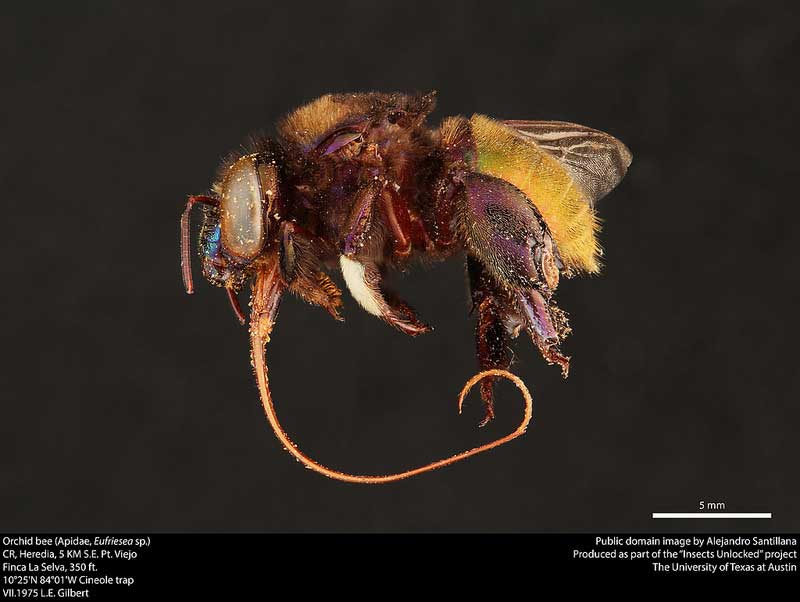Superregnum: Eukaryota
Cladus: Unikonta
Cladus: Opisthokonta
Cladus: Holozoa
Regnum: Animalia
Subregnum: Eumetazoa
Cladus: Bilateria
Cladus: Nephrozoa
Cladus: Protostomia
Cladus: Ecdysozoa
Cladus: Panarthropoda
Phylum: Arthropoda
Subphylum: Hexapoda
Classis: Insecta
Cladus: Dicondylia
Subclassis: Pterygota
Cladus: Metapterygota
Infraclassis: Neoptera
Cladus: Eumetabola
Cladus: Endopterygota
Superordo: Hymenopterida
Ordo: Hymenoptera
Subordo: Apocrita
Superfamilia: Apoidea
Familia: Apidae
Subfamilia: Apinae
Tribus: Euglossini
Genus: Eufriesea
Species: E. barthelli – E. chrysopyga - E. engeli – E. mexicana – E. oliveri – E. schmidtiana ...
Name
Eufriesea Cockerell, 1908

Eufriesea sp.
References
Cockerell, 1908
Ayala, R.; Engel, M.S. 2008: A new species of Eufriesea from Jalisco, México, with a key to Mexican species of the genus (Hymenoptera: Apidae). Beiträge zur entomologie, 58(2): 227–237.
Faria, L.R.R. & G.A.R. Melo, 2011: A new species of Eufriesea Cockerell (Hymenoptera, Apidae, Euglossina) from northeastern Brazil. Revista Brasileira de Entomologia 55 (1): 35–39. Abstract and full article: DOI: 10.1590/S0085-56262011000100007.
Gonzalez, V.H., Griswold, T. & Simões, M. 2017. On the identity of the adventive species of Eufriesea Cockerell in the USA: systematics and potential distribution of the coerulescens species group (Hymenoptera, Apidae). Journal of Hymenoptera Research 55: 55–102. DOI: 10.3897/jhr.55.12209 Open access. Reference page.
Griswold, T., Herndon, J.D. & Gonzalez, V.H. 2015. First record of the orchid bee genus Eufriesea Cockerell (Hymenoptera: Apidae: Euglossini) in the United States. Zootaxa 3957(3): 342–346. DOI: 10.11646/zootaxa.3957.3.7. Preview (PDF) Reference page.
Nemésio, A. 2007: Eufriesea atlantica sp. n. (Hymenoptera: Apidae), a new orchid bee from the Brazilian Atlantic Forest. Lundiana, 8(2): 147–152. PDF
Nemésio, A. 2011: Description of the male Eufriesea theresiae (Mocsáry, 1908) (Hymenoptera: Apidae: Euglossina), with illustration of the holotype and comments on its geographic distribution, including a new record for the state of Pará, northern Brazil. Zootaxa, 2762: 63–68. Preview
Nemésio, A.; Santos Júnior, J.E.; Santos, F. 2013: Eufriesea zhangi sp. n. (Hymenoptera: Apidae: Euglossina), a new orchid bee from Brazil revealed by molecular and morphological characters. Zootaxa 3609(6): 568–582. DOI: 10.11646/zootaxa.3609.6.2 [erratum in Zootaxa 3630(1): 200–200. DOI: 10.11646/zootaxa.3630.1.11 (2013) Reference page. ] Reference page.
Links
ION
Nomenclator Zoologicus
Eufriesea is a genus of euglossine bees. Like all orchid bees, they are restricted to the Neotropics.
All species range from entirely to at least partially metallic (the face and/or tegulae), though much of the body in some species may be brown/black in color and hairy.
Distribution
Eufriesea is the most widely distributed genus of euglossines. Specimens have been found from Mexico to central Argentina.[1]
E. purpurata
At least one of its species, Eufriesea purpurata from Brazil, has been shown to selectively collect large quantities of the insecticide DDT without any apparent adverse effects.[2] Individual bees were observed to collect as much as 2 mg. The males of orchid bees are known to collect aromatic fragrances from certain kinds of orchids, and it is thought that they use these in territorial display and courtship, probably as precursors of their own pheromones. Some orchid bees have also been found to collect fragrances from rotten wood.
Name
The genus is named after entomologist Heinrich Friese.
Species
E. aeniventris (Mocsáry, 1896)
Eufriesea andina (Friese, 1925)
E. anisochlora (Kimsey, 1977)
E. atlantica Nemésio, 2008
E. auriceps (Friese, 1899)
E. auripes (Gribodo, 1882)
E. bare González & Gaiani, 1989
Eufriesea barthelli Gonzalez & Griswold 2017
E. boharti (Kimsey, 1977)
E. brasilianorum (Friese, 1899)
Eufriesea buchwaldi (Friese, 1923)
E. caerulescens (Lepeletier, 1841)
E. chaconi González & Gaiani, 1989
E. chalybaea (Friese, 1923)
E. chrysopyga (Mocsáry, 1898)
E. combinata (Mocsáry, 1897)
E. concava (Friese, 1899)
E. convexa (Friese, 1899)
E. corusca (Kimsey, 1977)
Eufriesea dentilabris (Mocsáry, 1897)
E. distinguenda (Gribodo, 1882)
E. dressleri (Kimsey, 1977)
E. duckei (Friese, 1923)
E. eburneocincta (Kimsey, 1977)
E. elegans (Lepeletier, 1841)
Eufriesea engeli Gonzalez & Griswold 2017
E. excellens (Friese, 1925)
E. fallax (Smith, 1854)
E. flaviventris (Friese, 1899)
E. formosa (Mocsáry, 1908)
E. fragrocara (Kimsey, 1977)
Eufriesea heideri Nemésio & Bembé 2008
E. kimimari González & Gaiani, 1989
E. laniventris (Ducke, 1902)
E. limbata (Mocsáry, 1897)
E. lucida (Kimsey, 1977)
E. lucifera Kimsey, 1977
E. macroglossa (Moure, 1965)
E. magrettii (Friese, 1899)
E. mariana (Mocsáry, 1896)
E. mexicana (Mocsáry, 1897)
E. micheneri (Ayala & Engel, 2008)
E. mussitans (Fabricius, 1787)
E. nigrescens (Friese, 1925)
E. nigrohirta (Friese, 1899)
Eufriesea oliveri Gonzalez & Griswold 2017
E. opulenta (Mocsáry, 1908)
E. ornata (Mocsáry, 1896)
E. pallida (Kimsey, 1977)
E. pretiosa (Friese, 1903)
E. pulchra (Smith, 1854)
E. purpurata (Mocsáry, 1896)
Eufriesea pyrrhopyga Faria & Melo 2011
E. rufocauda (Kimsey, 1977)
E. rugosa (Friese, 1899)
E. schmidtiana (Friese, 1925)
E. simillima (Moure & Michener, 1965)
E. superba (Hoffmannsegg, 1817)
E. surinamensis (Linnaeus, 1758)
E. theresiae (Mocsáry, 1908)
E. velutina (Moure, 1999)
E. venezolana (Schrottky, 1913)
E. venusta (Moure, 1965)
E. vidua (Moure, 1976)
E. violacea (Blanchard, 1840)
E. violascens (Mocsáry, 1898)
E. zhangi Nemésio, Júnior and Santos, 2013
References
Anjos-Silva, Evandson J. dos; Camillo, Evandro; Garófalo, Carlos A. (December 2006). "Occurrence of Aglae caerulea Lepeletier & Serville (Hymenoptera: Apidae: Euglossini) in the Parque Nacional da Chapada dos Guimarães, Mato Grosso State, Brazil". Neotropical Entomology. 35 (6): 868–870. doi:10.1590/S1519-566X2006000600024. PMID 17273723.
Roberts, Donald R.; Alecrim, Wilson D.; Heller, Jack M.; Ehrhardt, Susan R.; Lima, Jose B. (6 May 1982). "Male Eufriesia purpurata, a DDT-collecting euglossine bee in Brazil". Nature. 297 (5861): 62–63. Bibcode:1982Natur.297...62R. doi:10.1038/297062a0. S2CID 4257709.
Further reading
Whitten, W. Mark; Young, Allen M. & Stern, David L. (1993): Nonfloral sources of chemicals that attract male euglossine bees (Apidae: Euglossini). Journal of Chemical Ecology 19(12): 1573–1561. doi:10.1007/BF00980599
Cameron, Sydney A. (2004): Phylogeny and Biology of Neotropical Orchid Bees (Euglossini). Annual Review of Entomology 49: 377–404. doi:10.1146/annurev.ento.49.072103.115855
Roubik, D. W. (1989): Ecology and natural history of tropical bees. New York: Cambridge Univ. Press.
Vetter, Walter & Roberts, Donald (2007): Revisiting the organohalogens associated with 1979-samples of Brazilian bees (Eufriesea purpurata). Science of the Total Environment 377: 371–377. doi:10.1016/j.scitotenv.2007.02.009
Retrieved from "http://en.wikipedia.org/"
All text is available under the terms of the GNU Free Documentation License

